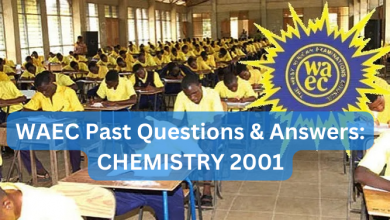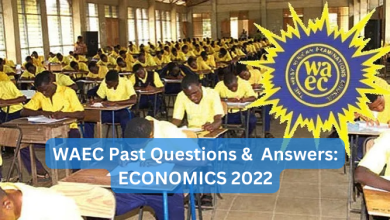WAEC Past Questions & Answer: CHEMISTRY 2021

Welcome to our WAEC past question and answer series. In this post, we will be sharing Chemistry 2021 past questions and their answers for various subjects. Stay tuned enjoy while learning.
1. The hydrolysis of proteins by diluting mineral acids produces
A. sucrose
B. glucose
C. amino acids
D. fatty acids
2. Which of the following oxide causes acid rain?
A. CO
B. NO
C. H2O2
D. NO2
3. The ratio of carbon atoms of hydrogen atoms in a hydrocarbon is 1:2. If its molecular mass is 56, what is its molecular formula?
A. C3H6
B. C4H8
C. C2H4
D. CH2
4. What is the relative molecular mass of the compound below?

What is the relative molecular mass of the compound below [H = 1.0; C = 12.0; O = 16.0] – SchoolNGR
[H = 1.0; C = 12.0; O = 16.0]
A. 137
B. 136
C. 64
D. 59
5. Cathodic protection of metals is based on
A. standard electrode potential of hydrogen
B. its electrical conductivity
C. nature of oxides formed
D. relative tendencies of oxidation
6. If humid air is polluted by chlorine discharged, the air can be restored by sprinkling
A. solid MnO2
B. acidified KMnO4
C. acidified FeSO4
D. saturated NaCl(aq)
7. The alkanol represented by the structure below is
A. primary and dihydric
B. secondary and monohydric
C. tertiary and dihydric
D. secondary and dihydric
8. Which of the following pairs of compounds would form a precipitate when their aqueous solutions are mixed?
A. NaCl and KNO3
B. KCL and NaNO3
C. K2SO4 and BaCl2
D. NH4NO3 and CO3
9. Which of the following illustrates the variation of the rate of evolution of gas from a given length of magnesium ribbon (y-axis) with an increase in the concentration of the added (x-axis)?
A. I
B. II
C. III
D. IV
10. Which of the graphs illustrates the variation of the pH of a given volume of strong acid solution (y-axis) with the volume of strong base titrated against its (x-axis)?
A. I
B. II
C. III
D. IV
11. Which of the graphs illustrates the variation of the solubility of a salt in water (y-axis), with an increase in temperature (x-axis) if the dissolution process is exothermic?
A. I
B. II
C. III
D. IV
12. The formation of ethene from dehydration of ethanol can be described as——-
A. an addition reaction
B. an elimination reaction
C. an oxidation reaction
D. a substitution reaction
13. Which of the following gasses is highly soluble in water at room temperature
A. ammonia
B. carbon (IV) oxide
C. chlorine
D. nitrogen
14. A molecular of phosphorus is
A. diatomic
B. triatomic
C. tetraatomic
D. monoatomic
15. The most common method of preparing insoluble salts is by
A. filtration
B. decomposition
C. neutralisation
D. double decomposition
16. What number of moles of oxygen would exert a pressure of 10 atm at 320 K in an 8.2 dm2 cylinder?
[R = 0.082 atm dm3 mol−1 K−1]
A. 0.32
B. 1.56
C. 3.13
D. 31.25
17. The basic property of salts used as drying agents is by?
A. efflorescence
B. high melting point
C. hygroscopy
D. low solubility
18. What would be observed when aqueous ammonia is added in drops and then in excess to a solution of copper(II) ions?
A. blue precipitate is formed which is soluble in excess ammonia
B. brick red precipitate is produced which is insoluble in excess ammonia
C. which precipitate is formed which is excess in ammonia
D. green precipitate is formed which is insoluble in excess ammonia
19. When CuSO4(aq) is added to Pb(NO3)2(aq)——–
A. there would be no visible change
B. a blue precipitate would be formed
C. the resulting solution would become colourless
D. a white precipitate would be formed
20. Consider the structure below
How many carbon atoms does the parent chain contain?
A. 5
B. 4
C. 3
D. 2
21. Under which conditions of pressure (p) and temperature (T) would the volume of an inflated ballon increase? When
A. P and T are increased
B. both T and P are decreased
C. T is increased and P is decreased
D. T is decreased and P is increased
22. The collision between ideal gas molecules are considered to be perfectly elastic because
A. they collide without losing energy
B. they move randomly in a straight line
C. their average kinetic energy is variable
D. the distance between them is large compared to their size
23. Elements with high ionisation energies would——-
A. lose electrons easily
B. have large atomic radii
C. have high effective nuclear charges
D. have low atomic numbers
24. Which of the following statements about Group VII elements is correct?
A. they are present in the same physical state
B. they are strong reducing agents
C. their reactivity decreases down the group
D. they exist as monoatomic molecules
25. Consider the following diagram and use it to answer the question below
Which of the following cell notations represent the diagram
A. B2+/B/ /A/A3+
B. A3+ /A/ /B/B2+
C. B/B2+/ /A/3+
D. A/A3+/ /B2+/B
26. Which of the following half reaction equations represent the reaction at the cathode
A. A3+(aq)+3e− → A(s)
B. B2+(aq)+2e− → B(s)
C. A(s) → 3+(aq)+3e−
D. B(s) → B2+(aq) + 2e−
27. The reactivity of fluorine is high because of
A. its high electronegativity
B. the small size of the fluorine atom
C. the availability of d-orbitals
D. the strong F-F bond
28. How many coulombs of electricity would liberate 1.08g of Ag from a solution of silver salt?
[Ag = 108.0; 1F = 96500 C]
A. 96500 C
B. 9650 C
C. 965 C
D. 9.65 C
29. The Bohr model of the atom proposed the existence of?
A. the nucleus
B. electron shells
C. nucleons
D. neutrons
30. The 25°C evaporation of a 100 cm3 solution of K2CO3 to dryness gave 14g of the salt. What is the solubility of K2CO3 at 25°25C? [K2CO3 = 138]
A. 0.01 mol dm−3
B. 0.101 mol dm−3
C. 1.01 mol dm −3
D. 10.0 mol dm−3
31. Student X titrated 25 cm3 of Na2CO3 with 0.1 mol dm−3 HCI, using methyl orange as indicator. Student Y carried out the same exercise but used phenolphthalein as an indicator. Which of the following statements about the titration is true?
A. hydrogen chloride gas was released in the reactions in both titrations
B. the titer values obtained from the titration are equal
C. the tirer value obtained by X is twice that of Y
C. the titer value obtained by Y is twice that of X
32. What is the concentration of a solution which contains 0.28g of potassium hydroxide in 100 cm3 of solution [KOH = 56]
A. 0.01 mol dm−3
B. 0.05 mol dm−3
C. 0.10 mol dm−3
D. 0.50 mol dm−3
33. What is the empirical formula of a hydrocarbon containing 0.160 moles of carbon and 0.640 moles of hydrogen
A. CH2
B. CH3
C. CH4
D. C2H4
34. Which of the following species has the largest ionic radius
A. S2−
A. K+
B. CI−
D. Ca2+
35. Which of the following statements is correct about ionisation energy? It
A. decreases across the periods
B. results in the formation of an anion
C. causes Metalic nuclei to disintegrate
D. decreases down the group
36. Potassium trioxonitrate (V) can be obtained from its solution by———-
A. distillation
B. evapoartion
C. crystallisation
D. filtration
37. An element, Q, contains 69% of63Q and 31% of 65Q. What is the relative atomic mass of Q?’
A. 63.0
B. 63.6
C. 65.0
D. 69.0
38. The following ions have the same electron configuration except
8O, 12Mg, 13AI, 17CI
A. CI−
B. O2−
C. Mg2+
D. AI3+
39. The region around the nucleus where electrons can be located is called?
A. a spectra
B. an orbital
C. a quanta
D. a field
40. Protons and electrons are called fundamental particles because they———-
A. are indivisible
B. have different charges
C. are the lightest particles
D. are found in all matter
41. The activation energy of the reaction is
A. EA
B. EB
C. EC
D. ED
42. The enthalpy change of the reaction is————
A. EA
B. EB
C. EC
D. ED
43. The energy profile diagram illustrates————-
A. an endothermic reaction
B. an exothermic reaction
C. a spontaneous reaction
D. a redox reaction
44. How many molecules of oxygen would occupy a volume of 2.24 cm3 at s.t.p?
[Molar volume at s.t.p = 22,400 cm3, Avogadro’s number = 6.02 x 1023]
A. 3.01 x 1020
B. 3.01 x 1027
C. 6.02 x 1019
D. 6.02 x 1027
45. The isotopes of neon are represented by the symbols 20x Ne, 21 y Ne, and 22 z Ne. The relationship between x, y, and z is?
A. x > y > z
B. x < y < z
C. x = y= z
D. x < z < y
46. Which of the following pairs of molecules form hydrogen bonds?
A. C2H5OH and CH3OH
B. CH3OH and H2
C. H2S and CH4
D. NH3 and SO2
47. Which of the following statements about elements in Group VII is correct?
A. Br2 will oxidise CI−
B. F2 has the least tendency to be reduced
C. Cl2 will oxidise I−
D. l2 is a stronger oxidising agent than F2
48. Electrovalent compounds normally ————
A. have low boiling points
B. have mobile electrons
C. conduct electricity in the solid state
D. dissolve in polar solvent
49. A coordinate covalent bond could be formed between?
A. NH3 and PCl3
B. BCl3 and AlCl3
C. BCl3 and NH3
D. H+ and AlCl3
50. Which of the following scientists discovered the electrons?
A. Joseph J. Thompson
B. James Chadwick
C. Amedeo Avogadro
D. Ernest Rutherford
Answers To Questions
- C
- D
- B
- B
- D
- B
- A
- B
- A
- A
- D
- B
- A
- C
- C
- D
- C
- A
- D
- A
- C
- A
- C
- C
- D
- B
- A
- C
- B
- C
- B
- B
- C
- A
- D
- C
- B
- A
- B
- D
- C
- D
- B
- C
- C
- A
- B
- D
- C
- A




